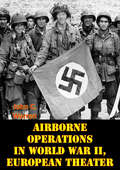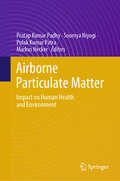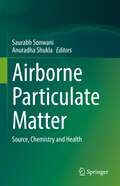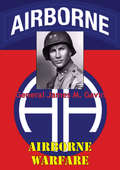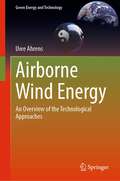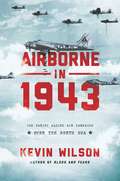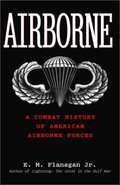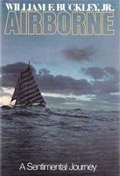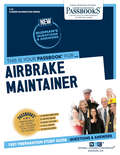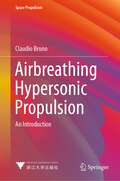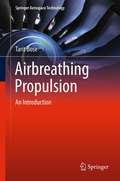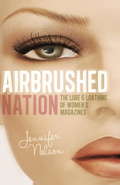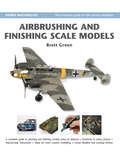- Table View
- List View
Airborne Occupational Hazards in Sewer Systems
by Amy Forsgren Kristina BrinckSewer systems fall into the category "out of sight, out of mind" – they seldom excite interest. But when things go wrong with the air in the sewer system, they go very wrong. Consequences can be dramatic and devastating: sewer workers killed instantly by poisonous gas when they lift a sewer lid, or entire suburban blocks levelled by explosions. This book describes the atmospheric dangers commonly found in the sewer system. It provides easily-understood explanations of the science behind the hazards, combined with real-life examples of when things went dramatically wrong.
Airborne Operations In World War II, European Theater [Illustrated Edition]
by Dr John C. WarrenIncludes 12 maps, 12 photos and 2 charts.THE seminal study of the Allied large scale airdrops of the Second World War in the European Theater."The first combat airborne missions in history were flown by the Germans in 1940. Recognizing the possibilities of such operations, the British and Americans followed suit. The first British mission was flown in February 1941, and the first American mission was flown from England to Oran, Algeria, on 8 November 1942 as part of the Anglo-American invasion of North Africa. Other, later missions, principally in the Mediterranean region, provided the American troop carriers with an apprenticeship in airborne warfare. However, until the summer of 1944 no force larger than a reinforced regimental combat team was flown into action in any Allied mission. In World War II the only Allied airborne operations employing more than one division took place in the invasion of Normandy, the unsuccessful attempt to win a bridgehead across the Rhine at Arnhem, and the successful crossing of the Rhine at Wesel. Consequently the study of airborne missions in the European Theater of Operations is of particular importance for the light it throws on the planning and performance of large-scale airborne assaults."
Airborne Particulate Matter: Impact on Human Health and Environment
by Markus Hecker Pratap Kumar Padhy Soumya Niyogi Pulak Kumar PatraParticulate matter (PM) in the ambient air is a key indicator of air pollution. It can be suspended over long time and travel over a long distance in the atmosphere. It can cause a wide range of diseases that lead to a significant reduction of human life. Because of the potent role of PM and its associated pollutants, detailed knowledge of their effects on the environment in general, and human health in particular, is of primary importance. This book provides an in-depth overview of monitoring of airborne particulates and their sources and transport. The dynamics of nutrients, intake pathways of particulates by human body and other components of environment, and their possible health hazards and effects at different levels and at various organs are discussed. With contributions from well-known experts from diverse research fields, including medical and public health science professions, this book provides an exhaustive information on the health risks of air pollution and explores its control and mitigation strategies. In addition to providing a scientific basis for particulate air pollution, this book will also help readers, researchers and public health professionals to appreciate the environmental determinants of public health and apply research evidence for improving the quality of life. This will also delineate future research initiatives and policy actions needed with more stringent strategies for protecting the environment in general and human health in particular from PM at local, regional, and global levels.
Airborne Particulate Matter: Source, Chemistry and Health
by Anuradha Shukla Saurabh SonwaniThis book is about airborne particulate matter, sources, chemistry and health and contained a complete information about their emission source, transport, atmospheric chemistry, distribution at local, regional and global levels, and their level in indoor and outdoor settings. Primary and secondary particulate matters in the ambient atmosphere also describe in detail. Analytical techniques, statistical tools and mathematical models used in airborne particulate research is also described. This book also covers the important aspects of the particulate matter chemistry in atmosphere, and their adverse impact on plant and human health. A detailed insight about the harmful impact of airborne particulate matter (biogenic and anthropogenic both) on different human system is described in detail. The toxicological significance of particulate matter on human body was also mentioned. The mitigation, management and regulatory policies to control ambient particulate matter is also provided. This book is also written in simple language with helpful photographs, diagrams, tables and flowcharts which will make the reader comfortable in understanding the concepts a more relatively easier way. Overall, the present book is a valuable tool for students working in the fields of Atmospheric Science, Environmental Science, Biological Sciences, Epidemiology and Agriculture Science. This book also a unique resource for environmental consultants, researchers, policymakers and other professionals involved in air quality, plant and human health.
Airborne Platforms to Advance NASA Earth System Science Priorities: Assessing The Future Need For A Large Aircraft
by Space Studies Board Division on Engineering and Physical Sciences Division on Earth and Life Studies Board on Atmospheric Sciences and Climate National Academies of Sciences, Engineering, and Medicine Committee on Future Use of NASA Airborne Platforms to Advance Earth Science PrioritiesThe National Aeronautics and Space Administration (NASA) and other U.S. science research agencies operate a fleet of research aircraft and other airborne platforms that offer diverse capabilities. To inform NASA’s future investments in airborne platforms, this study examines whether a large aircraft that would replace the current NASA DC-8 is needed to address Earth system science questions, and the role of other airborne platforms for achieving future Earth system science research goals.
Airborne Warfare
by General James Maurice Gavin William C. LeeTo every member of the 82nd Airborne Division who dropped as part of the American paratroop landings during World War Two, they breathed a little easier knowing their commander "Jumpin' Jim" Gavin would be dropping with them. General Gavin would drop into the fierce fighting along with his men in Sicily, Normandy on D-Day and during the abortive attempt to capture the Rhine bridges during Operation Market-Garden. He shared the risks of all his men dropping into enemy territory, often only armed with his GI issue rifle and accompanied by a handful of men, leading from the front his memoirs are an outstanding addition to the literature of the Airborne in World War II.General Gavin had been at the forefront advancing the use of airborne troops in the US army, writing the first field manual for their combat use. In this volume of memoirs General Gavin recounts his many experiences in the Airborne and also writes of the need and use of airborne troops in the future.
Airborne Wind Energy: An Overview of the Technological Approaches (Green Energy and Technology)
by Uwe AhrensThis book shows possible solutions to how a profitable energy supply can be implemented with almost no population resistance. Worldwide, more than 80 % of our energy needs are still covered by fossil fuels. Under these circumstances, can climate change still be stopped? Essential technologies for usage of wind energy with an emphasis on high-altitude wind utilization are presented. Airborne wind energy is one of the most promising technologies to enable a renewable energy turnaround in an economical way. The main problem of conventional renewable energy is the insufficient availability. To ensure a 100 % supply of renewable energy, enormous and very expensive storage capacities would have to be built up. How we can cover our entire energy needs (electricity, mobility and heat) in the future without fossil fuels, without risking the competitiveness of our economy, is shown in this book.
Airborne in 1943: The Daring Allied Air Campaign Over The North Sea
by Kevin WilsonA gripping account of the heroism of bomber planes in 1943—the year the “Dambusters” embarked on a campaign to try to win World War II in one quick stroke. The year 1943 saw the beginning of an unprecedented bombing campaign against Germany. Over the next twelve months, tens of thousands of aircrews flew across the North Sea to drop bombs on German cities. They were opposed not only by the full force of the Luftwaffe, but by a nightmare of flak, treacherously icy conditions, and constant mechanical malfunction. Most of these courageous crews were either shot down and killed or taken prisoner by an increasingly hostile enemy. This is the story of the everyday heroism of these crews in the days when it was widely believed that the Allies could win the Second World War by air alone. American pilots had a special role in the “Dambusters” campaign in particular. Even before the attacks on Pearl Harbor, scores of eager pilots travelled across the Canadian border to train with other future “Dambusters,” all eager to take part. Authoritative and gripping, Airborne in 1943 brings these remarkable men and women to vivid life.
Airborne: A Combat History of American Airborne Forces
by Edward M. Flanagan Jr.A combat history of American airborne forces up to the Gulf War.
Airborne: A Sentimental Journey
by William F. Buckley Jr.Excerpts from the ship's log as Buckley sails across the Atlantic Ocean with his son and some friends, along with his musings on sailing and seamanship.
Airborne: Assault From the Sky
by Hans HalberstadtThey are fighting men of legendary courage. Volunteers who submit to the most brutal training the army has to offer--they are airborne warriors who jump from planes into the heart of combat, fully armed and ready to fight the moment they touch ground. The men of the airborne wear their wings with pride, for they are symbols earned with sweat and blood. Now, author/photographer Hans Halberstadt takes you into the lives of America's airborne soldiers. Follow these fearless men from their intensive ground training to airborne action. 1988.
Airbrake Maintainer: Passbooks Study Guide (Career Examination Series #C-12)
by National Learning CorporationThe Airbrake Maintainer Passbook® prepares you for your test by allowing you to take practice exams in the subjects you need to study. It provides hundreds of questions and answers in the areas that will likely be covered on your upcoming exam, including but not limited to: Mechanical and pneumatic principles and devices; Installation, testing, maintenance and repair of such devices; Reading and understanding mechanical and pneumatic manuals and drawings; safe work practices and procedures; and other related areas.
Airbreathing Hypersonic Propulsion: An Introduction (Space Propulsion)
by Claudio BrunoThis book details science of hypersonics especially focusing on propulsion aspects such as supersonic combustion ramjets and their applications, and also includes lift and drag in hypersonic flight and their mathematical and physical explanation. It provides charts and data from hypersonic testing and measurements from actual vehicles and engines built in the past. Criteria to dimension hypersonic powered and unpowered vehicles (gliders) based on fundamental fluid dynamics and backed by flight testing; criteria to preliminary sizing vehicles and preliminary dimensioning of supersonic combustors are introduced. The book will serve better theoretical understanding of drag, lift and how to apply them to the design of hypersonic vehicles, as well as data to size vehicles and supersonic combustion ramjet (SCRJ) systems. This book will be a useful reference for researchers and designers in hypersonic vehicles but also second or third-year graduate students.
Airbreathing Propulsion: An Introduction (Springer Aerospace Technology)
by Tarit BoseAirbreathing Propulsion covers the physics of combustion, fluid and thermo-dynamics, and structural mechanics of airbreathing engines, including piston, turboprop, turbojet, turbofan, and ramjet engines. End-of-chapter exercises allow the reader to practice the fundamental concepts behind airbreathing propulsion, and the included PAGIC computer code will help the reader to examine the relationships between the performance parameters of different engines. Large amounts of data have on many different piston, turbojet, and turboprop engines have been compiled for this book and are included as an appendix. This textbook is ideal for senior undergraduate and graduate students studying aeronautical engineering, aerospace engineering, and mechanical engineering.
Airbrushed Nation: The Lure and Loathing of Women's Magazines
by Jennifer NelsonGlamour. Cosmo. SELF. Ladies’ Home Journal. Vogue. In an industry that has been in a downward spiral for years, these magazines-and other women-focused magazines like them-have not only retained their readership, they’ve increased it. Every month, five million-plus women peel back the slick cover of their favorite magazine to thumb through pages filled with tidings and advice about fashion, beauty, sex, relationships, dieting, health, and lifestyle. But do women’s magazines offer valuable information, or do they merely peddle fluff and fantasy-and in either case, do women take their messages to heart? InStiletto Nation,Jennifer Nelson-a longtime industry insider-exposes the naked truth behind the glossy pages of women’s magazines, both good and bad. Nelson delves deep into the world of glossies, explaining the ways in which these magazines have been positive for women, highlighting the ways in which their agendas have been misguided, and asking the questions that have long gone unasked: What do women think and believe about the retouched photos, the ubiquitous sex advice, the constant offensive on aging, and the fantasy fashion spreads featuring unaffordable clothing and accessories? Do the unrealistic ads, images, and ideals that permeate glossies damage women’s self-esteem . . . and is it intentional?
Airbrushing and Finishing Scale Models
by Brett GreenA convincing paint finish is essential for any model, be it military or civilian, aircraft, vehicles, figures or even background items such as terrain or buildings - and good airbrushing and finishing techniques can be the key to creating a superior model. Over the last few years there have been huge strides made in the development of airbrushes, paints and thinners, and consequently, this new book will provide up-to-date practical information and illustrated techniques to take full advantage of these new technologies.Brett Green details the prerequisites of airbrushing, including the different types of spray equipment and air sources available, offering advice on appropriate thinners, paint ratios and air pressures to ensure the most appropriate paint coverage across a range of different airbrushing applications. He then examines various airbrushing techniques across a wide range of models. Ten step-by-step, illustrated case studies ranging from heavily weathered military aircraft to pristine, high gloss motor vehicles, science fiction models, fantasy figures, groundwork and buildings will complete this in-depth guide to getting the best results on your models.From the Hardcover edition.
Airbus A380 (Flight Craft #23)
by Robert Jackson Glen Ashley“A great addition to the highly popular Flight Craft Series. This book reviews the history of . . . an iconic and important aircraft in civil aviation.” —FiretrenchOn April 27 2005, an aircraft under the power of six massive Rolls-Royce Trent 900 turbofan engines was making its first flight, and it was making history. For this was the Airbus A380, the largest passenger aircraft in the world. With air traffic continuing to double every fifteen years, the A380 was designed by Airbus Industrie to meet the needs of the passengers and airports, while also delivering the level of efficiency necessary to protect the environment for future generations. The design incorporated two full-length decks with wide-body dimensions, meaning its two passenger levels offered an entire deck’s worth of additional space compared to the next largest twin-engine jetliner. With more seats than any other aircraft, the A380 offered solutions to overcrowding; needing fewer journeys to carry 60 percent more passengers, making it the perfect solution to airport congestion, fleet planning optimization and traffic growth. Typical seating capacity was 525, although the aircraft was certified to carry up to 853 passengers. Production of the A380 peaked at thirty aircraft per year in 2012 and 2014. Then, in February 2019, the biggest customer, Emirates, announced that it was to reduce its latest order by thirty-nine aircraft in favour of two other Airbus Models, the A350 and A330neo, a version using the same engines as the Boeing 787 Dreamliner. For Airbus, it was the last act. The Company announced that production of the A380 would cease by 2021.“Full of great information.” —Airport Spotting
Airbus A3XX: Developing the World's Largest Commercial Jet (A)
by Michael Kane Benjamin C. EstyIn July 2000, Airbus Industries' supervisory board is on the verge of approving a $13 billion investment for the development of a new super jumbo jet known as the A3XX that would seat from 550 to 1,000 passengers. Having secured approximately 20 orders for the new jet, the board must decide whether there is sufficient long-term demand for the A3XX to justify the investment. At the time, Airbus was predicting that the market for very large aircraft (VLA), those seating more than 500 passengers, would exceed 1,500 aircraft over the next 20 years and would generate sales in excess of $350 billion. According to Airbus, it needed to sell 250 aircraft to break even and could sell as many as 750 aircraft over the next 20 years. This case explores the two sets of forecasts and asks students whether they would proceed with the launch given the size of the investment and the uncertainty in long-term demand.
Airbus A3XX: Developing the World's Largest Commercial Jet (B)
by Michael Kane Benjamin C. EstySupplements the (A) case.
Airbus versus Boeing (A)
by Ramon Casadesus-Masanell Eric Van Den SteenLooks at the development of the competitive actions between Airbus and Boeing from 1992 to 2006. Begins with the question of whether Airbus and Boeing should collaborate on the development of a VLCT (Very Large Commercial Transport) or whether Airbus should develop their own. The case series moves through to the events thereafter of Airbus' decision to pursue the A380 and Boeing's decision relating to developing a stretch 747.
Airbus versus Boeing (A)
by Ramon Casadesus-MasanellLooks at the development of the competitive actions between Airbus and Boeing from 1992 to 2006. Begins with the question of whether Airbus and Boeing should collaborate on the development of a VLCT (Very Large Commercial Transport) or whether Airbus should develop their own. The case series moves through to the events thereafter of Airbus' decision to pursue the A380 and Boeing's decision relating to developing a stretch 747.
Airbus vs. Boeing (A)
by Ramon Casadesus-Masanell Jordan Mitchell Erich Alexander VoigtLooks at the development of the competitive actions between Airbus and Boeing from 1992 to 2006. Begins with the question of whether Airbus and Boeing should collaborate on the development of a VLCT (Very Large Commercial Transport) or whether Airbus should develop their own. The case series moves through to the events thereafter of Airbus' decision to pursue the A380 and Boeing's decision relating to developing a stretch 747.
Airbus vs. Boeing (A): Turbulent Skies
by Malcolm S. Salter Irence L. SinrichPresents the economic and political dimensions of competition in the commercial aircraft industry, as demonstrated by Airbus of Europe and Boeing of the United States.
Airbus vs. Boeing (B): Should Airbus Build the VLCT Alone?
by Ramon Casadesus-Masanell Jordan MitchellAn abstract is not available for this product.
Airbus vs. Boeing (G): New Planes and Upgrades (2011)
by Ramon Casadesus-Masanell Karen EltermanThis case describes the first commercial flight of Boeing's 787 Dreamliner in 2011, three years after originally planned, as well as the first commercial flight of Airbus's superjumbo, the A380, in 2007. It also describes the companies' current endeavors in 2011, including Airbus's work on the A350 and A320neo and Boeing's development of the 737 MAX.

